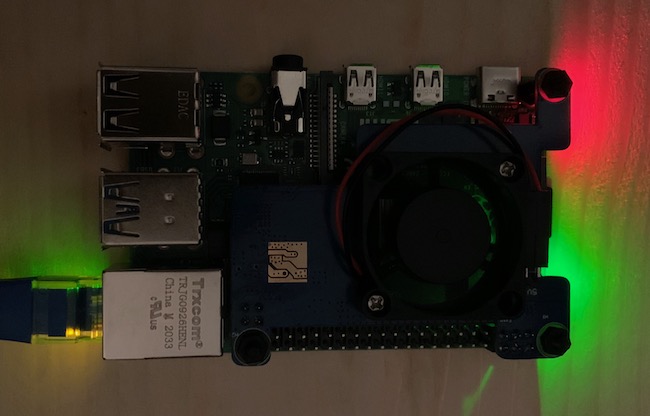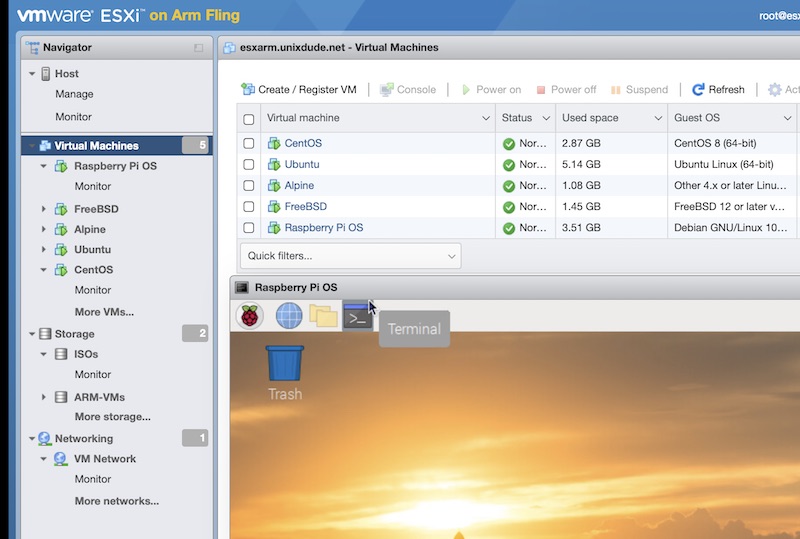Not long after my last post, the PoE HAT for my Raspberry Pi died -- to be more accurate, one of the components on the board disintegrated. I don't know if this was a manufacturing defect or the result of a bad solder job related to the fan, or something else. In any case, disposed of that HAT and ordered the GeeekPi PoE HAT. My ESXi-on-ARM setup has been up and running since, connected by a single cable.

I have this system booting from iSCSI, so there are no local filesystems -- the SD card is used only to initiate the boot process, the system boots from iSCSI, and datastores are on the filer and are accessed via NFS. I love the elegance of this setup.

So far, I have created several VMs: Alpine, CentOS 8, Ubuntu, Raspberry Pi OS, and FreeBSD. I haven't really done much with any of this, but in my time with it so far I am impressed with its speed. Speed-wise, it obviously doesn't compare to my R610, but for about $100, it's great for what it is, and it makes an excellent geek toy. And yes, I bought it mostly as a toy, but I do plan to use it for some real-world services: In addition to general OS play, I plan to at least add a VM here to my anycast DNS setup.
I might also build a VM on this server in order to relocate my UniFi controller. I'm undecided because I'm not sure how much I like the problem that involves: if the raspi dies, so does my ability to run my controller. Solving this problem is important since I currently run my UniFi controller in a VM that is hosted on my R610 and is NFS mounted. I do need to find another solution to the UniFi controller issue, since there are two switches between my R610 and my filer -- meaning that whenever I upgrade one of those switches, I have to reloate the controller VM to my iMac. This is not how you should do it!
I haven't installed vSphere in a while, but now that I have two ESXi servers, I might do that again, so that I can manage this entire setup more easily.
Daniel's Blog
I am a system engineer in the Raleigh, NC area. My main interests are Unix, VMware, and networking. More about me, and how I got started.
Categories
Tags
- IC-7300 1
- T1 1
- ansible 2
- anycast 2
- atari 1
- autofs 1
- backup 1
- battery box 1
- bgp 1
- cables 2
- cisco 2
- dashcam 1
- digitalocean 2
- disney 1
- diy 6
- dkim 1
- dns 2
- docker 6
- dsm 1
- ecmp 1
- email 2
- encryption 1
- esp32 2
- esphome 2
- esxi 4
- f150 3
- freebsd 1
- frr 3
- ft7800r 3
- ftm400 1
- git 1
- ham radio 6
- hardware 1
- home assistant 4
- home automation 2
- home lab 1
- homelab 2
- icloud 1
- ipad 1
- iphone 1
- iscsi 1
- kasa 1
- letsencrypt 1
- m5stack 2
- m900 1
- mac 1
- macos 3
- mikrotik 1
- minfs 1
- mobile 1
- monitoring 1
- nas 1
- network 1
- networking 3
- nfs 3
- ospf 4
- pelican 1
- perl 1
- php 1
- pi-hole 2
- plex 1
- portainer 1
- postfix 5
- pota 1
- prepping 1
- printer 1
- pxe 2
- python 1
- r610 3
- rack 4
- radio box 1
- raspberry pi 9
- raspi 1
- routing 2
- rsync 1
- scanner 3
- shell 4
- solenoid 1
- spf 1
- ssh 2
- ssl 2
- synology 8
- tinyminimicro 1
- traefik 2
- ubiquiti 6
- udm-se 1
- unix 8
- update 2
- usg 5
- virtualization 4
- vmware 4
- wireguard 6
- ysf 1
- zerotier 6